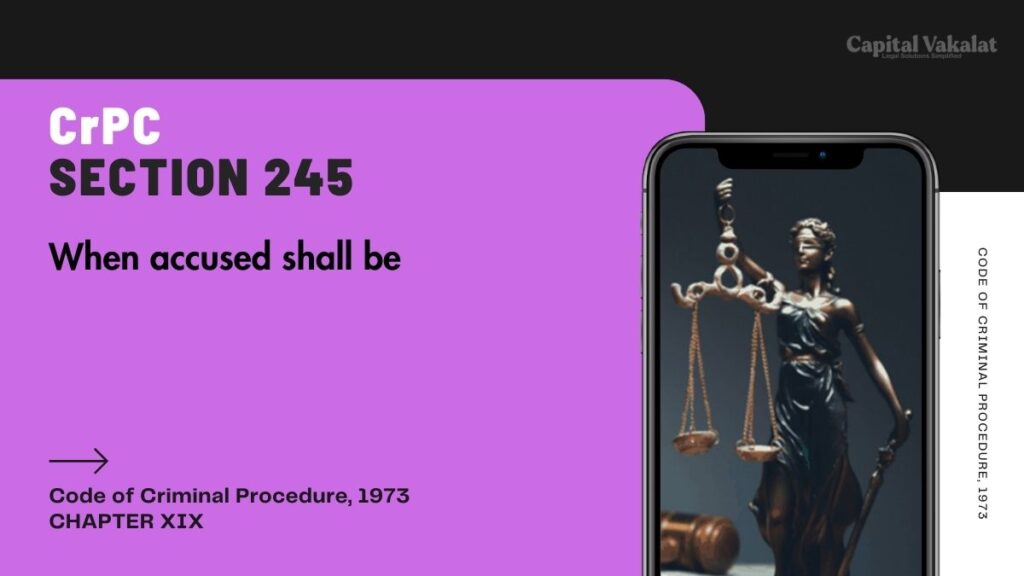In the criminal justice system, Section 245 of the Code of Criminal Procedure (CrPC) in India plays a crucial role. This section is primarily concerned with the discharge of an accused person in cases where there is insufficient evidence to warrant a conviction.

This article delves deep into the nuances of Section 245 CrPC, examining its provisions, legal interpretations, and practical applications.
Bare Act. Section 245 Cr.P.C.
When accused shall be discharged.
(1) If, upon taking all the evidence referred to in section 244, the Magistrate considers, for reasons to be recorded, that no case against the accused has been made out which, if unrebutted, would warrant his conviction, the Magistrate shall discharge him.
(2) Nothing in this section shall be deemed to prevent a Magistrate from discharging the accused at any previous stage of the case if, for reasons to be recorded by such Magistrate, he considers the charge to be groundless.
STATE AMENDMENT
West Bengal
In section 245 of the principal Act, after sub-section (2), the following sub-section shall be inserted: --
"(3) If all the evidence referred to in section 244 are not produced in support of the prosecution within four years from the date of appearance of the accused, the Magistrate shall discharge the accused unless the prosecution satisfies the Magistrate that upon the evidence already produced and for special reasons there is ground for presuming that it shall not be in the interest of justice to discharge the accused.".
[Vide West Bengal Act 24 of 1988, s. 5.]
Historical Context and Evolution of Section 245 CrPC
Section 245 CrPC, like many provisions in Indian law, has its roots in colonial legislation. The CrPC was originally enacted in 1973, succeeding earlier laws that governed criminal procedures in India. Over the years, it has undergone several amendments to better serve the principles of justice and fairness.
Understanding the Provisions of Section 245 CrPC
The key provision under Section 245 CrPC states that if, upon taking all the evidence referred to in Section 244, the Magistrate considers that no case against the accused has been made out which, if unrebutted, would warrant his conviction, the Magistrate shall discharge him. This means that the court must discharge the accused if the evidence presented is insufficient to prove the charge beyond a reasonable doubt.
The Role of the Magistrate Under Section 245 CrPC
The Magistrate’s role is pivotal in the application of Section 245 CrPC. They must evaluate the evidence impartially and decide whether the prosecution has established a prima facie case. This evaluation requires a thorough understanding of both the legal framework and the specific circumstances of the case.
Judicial Interpretations of Section 245 CrPC
Over the years, Indian courts have provided several interpretations of Section 245 CrPC to clarify its application. These judicial pronouncements have helped shape the understanding of when an accused should be discharged, ensuring consistency and fairness in legal proceedings.
Case Laws Influencing Section 245 CrPC
Numerous case laws have influenced the application of Section 245 CrPC. For instance, in State of Bihar v. Ramesh Singh, the Supreme Court emphasized that the evidence must be considered in totality rather than in isolation. This holistic approach ensures that the accused is discharged only when there is genuinely insufficient evidence.
The Procedure for Discharge Under Section 245 CrPC
The procedure for discharge under Section 245 CrPC involves several steps. Initially, the prosecution presents its evidence. The defense can then argue that the evidence is insufficient. The Magistrate must carefully scrutinize the evidence and make a reasoned decision. If the evidence is inadequate, the Magistrate is bound to discharge the accused.
Practical Implications of Section 245 CrPC
Ensuring Justice Through Discharge
The provision for discharge under Section 245 CrPC is vital for ensuring that individuals are not wrongfully prosecuted. It acts as a safeguard against unnecessary legal harassment and protects the rights of the accused.
Challenges in the Application of Section 245 CrPC
Despite its importance, the application of Section 245 CrPC is not without challenges. One significant issue is the subjective nature of determining whether the evidence is sufficient. This subjectivity can lead to inconsistencies in how the law is applied across different cases and jurisdictions.
The Importance of Legal Representation
Having competent legal representation is crucial for an accused person under Section 245 CrPC. A skilled lawyer can effectively argue for discharge by highlighting the insufficiency of evidence, ensuring that the rights of the accused are protected.
Section 245 CrPC in Comparison with International Standards
Comparative Analysis with Other Jurisdictions
A comparative analysis reveals that similar provisions exist in other legal systems worldwide. For example, in the United States, the principle of “no case to answer” serves a similar purpose. Such comparisons highlight the universal importance of protecting individuals from unfounded legal proceedings.
Learning from International Practices
Examining how other countries implement similar provisions can provide valuable insights for improving the application of Section 245 CrPC in India. Best practices from around the world can help address the challenges and enhance the fairness of the legal process.
Future Directions and Reforms for Section 245 CrPC
Proposed Reforms to Enhance Clarity and Fairness
Legal experts have proposed several reforms to enhance the clarity and fairness of Section 245 CrPC. These include clearer guidelines for Magistrates on evaluating evidence and more detailed procedures to ensure consistency in discharge decisions.
The Role of Technology in Legal Proceedings
The integration of technology in legal proceedings can also play a significant role in the future application of Section 245 CrPC. For instance, digital evidence management systems can help ensure that all evidence is accurately presented and evaluated.
Conclusion: Upholding Justice Through Section 245 CrPC
Section 245 CrPC is a cornerstone of the Indian criminal justice system, ensuring that individuals are not subjected to wrongful prosecution. By understanding its provisions, judicial interpretations, and practical applications, we can appreciate its role in upholding justice and protecting the rights of the accused.